The Hisense S7NQ Canvas TV is a very interesting proposition, especially for those looking for something in the style of a picture-television but do not want to spend a fortune. At first glance, it stands out primarily because the gallery mode featuring works of art is completely free – there is no subscription to pay, as is the case with Samsung's The Frame. Moreover, in the box, we immediately get a light brown frame, which will be an additional bonus and saving for many people. Although it is essentially a TV for displaying art, surprisingly, it also performs quite well in other applications. The 144 Hz panel, full HDMI 2.1, support for VRR and ALLM – all this makes gaming on consoles quite possible and quite enjoyable. The Vidaa system operates smoothly, and we find all the most important apps and features here, such as AirPlay, USB recording, or screen mirroring from a phone. However, there are also things that fall a bit short. Above all – the images themselves. Compared to The Frame by Samsung, here they simply look more digital. It lacks the depth, texture of paint, and subtle details that really impress with the competitor. Although at first glance we are dealing with a similar matte panel, in practice, it performs significantly worse at suppressing reflections. Colours and blacks fade much quicker, especially in a bright room. This could also be the effect of lower brightness – Hisense is simply darker than its Korean rival. On top of that, there are minor software issues – for example, the inability to display external subtitles despite configuration options, or the not entirely effective image smoothing feature for lower quality materials. In short: the S7NQ is a good TV in the form of a "picture," which can be a great alternative for those who do not mind the lower quality of displayed works but appreciate the lack of subscription fees, an additional frame included in the package, and full functionality of a typical television. It is not an ideal product, but a reasonable compromise for Samsung's The Frame.
- Matching (Score)
- Our verdict
- TV appearance
- Where to buy
- Contrast and black detail
- HDR effect quality
- Factory color reproduction
- Color reproduction after calibration
- Smoothness of tonal transitions
- Image scaling and smoothness of tonal transitions
- Blur and motion smoothness
- Console compatibility and gaming features
- Input lag
- Compatibility with PC
- Viewing angles
- TV efficiency during daytime
- Details about the matrix
- TV features
- Apps
- Playing files from USB
- Sound
Hisense S7NQ CanvasTV vs TCL C7K / QM7K
Direct compare
S7NQ / CanvasTV
C7K / Q7C / MQLED85K / C79K / C71K / QM7K
Available screen sizes: 55”

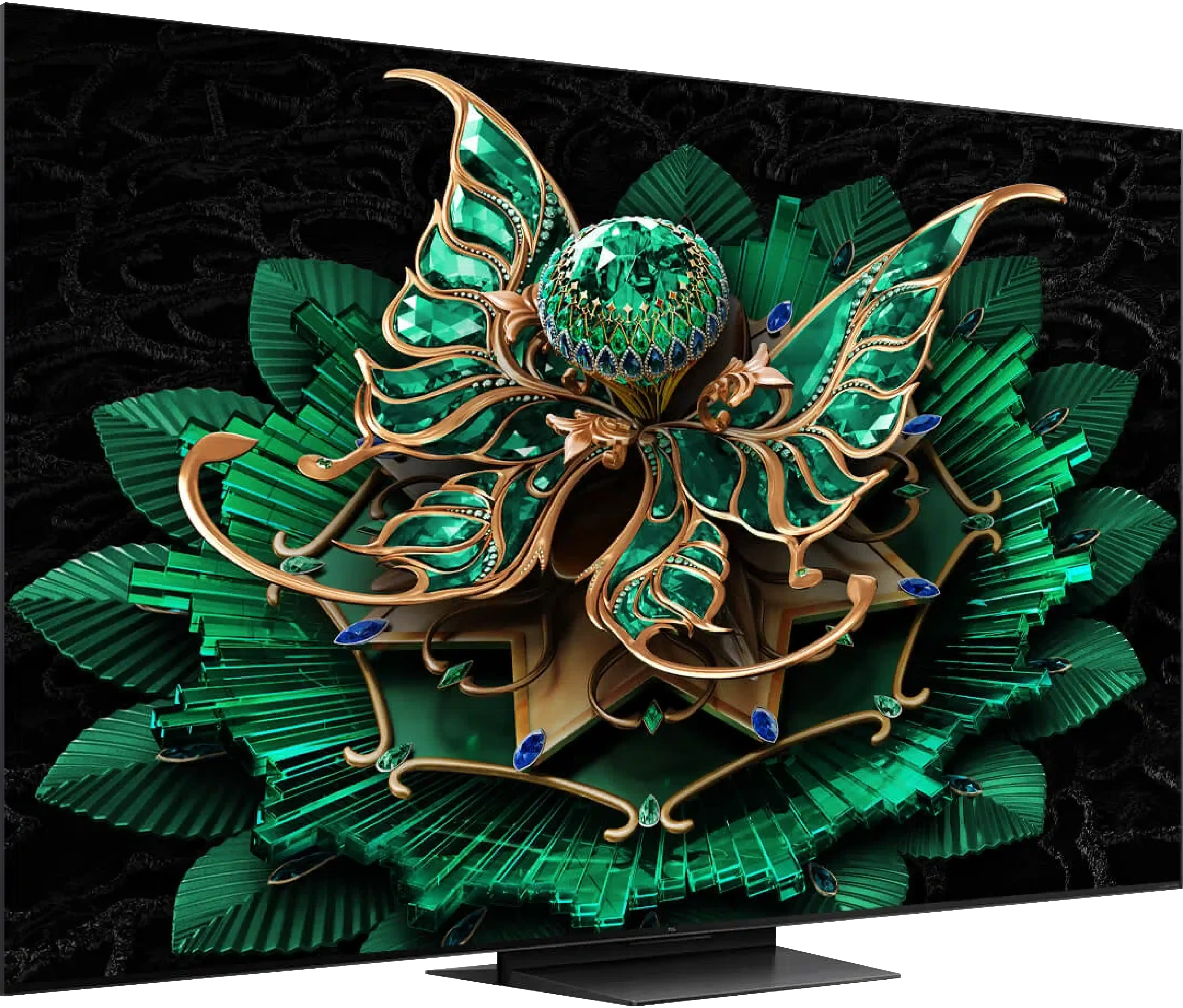
Panel type: LCD VA
Resolution: 3840x2160
System: VIDAA
Model year: 2024
Complete the survey to find out the result

Panel type: LCD VA
Resolution: 3840x2160
System: Google TV
Model year: 2025
Complete the survey to find out the result

Overall rating
6.7
7.1
Movies and series in UHD quality
6.6
6.7
Classic TV, YouTube
6.3
6.5
Sports broadcasts (TV and apps)
6.1
6.4
Gaming on console
7.5
8.5
TV as a computer monitor
7.0
8.4
Watching in bright light
5.4
6.1
Utility functions
9.0
7.7
Apps
7.7
9.6
Sound quality
6.3
7.0
Complete the survey to find out what fits your preferences
Advantages
Free gallery without a subscription
Frame included
Good for gamers (144 Hz, HDMI 2.1, VRR, ALLM, Game Bar)
Supports Dolby Vision, HDR10 and HDR10+
Decent native contrast (VA Panel)
Works well with PC (chroma 4:4:4)
Fast Vidaa System
Straightforward connection to home cinemas: Supports Dolby and DTS codecs
Very good black - VA panel with a large number of Mini-LED zones
High brightness in HDR - over 1000 nits
Excellent for gamers - HDMI 2.1, low input lag, VRR, ALLM, etc.
Good motion smoothness - 144Hz panel
Supports multiple HDR formats: HDR10, HDR10+, Dolby Vision
Google TV operating system with access to a vast array of applications
Pleasant sound from built-in speakers
Disadvantages
Worse quality of displayed images in gallery mode than in Samsung The Frame
Colours and black fade significantly in bright surroundings
Lack of HGiG mode (for gamers)
Software issues - no display of external subtitles in films
Google TV can operate with minor stutters
No USB recording and PiP functionality
Our verdict
There are televisions that come for testing, and you immediately think: “oh, just another average one, probably like many others.” And basically… that’s true. The TCL C7K doesn’t try to dethrone OLEDs, nor does it shout from the box “revolution!” Yet, after a few days of testing, it’s hard not to think: “wow, this is really good equipment.” And that’s exactly what the C7K is. The biggest asset of the C7K is its decent picture at a reasonable price – MiniLED and quantum dots do their job here. The colours are vibrant, the brightness satisfactory, the contrast impressive, and with the right settings, you can truly enjoy viewing in the best quality. The second strong point is the smoothness of motion – both in sports and games. Support for HDMI 2.1, variable refresh rates, 144 Hz, and a whole host of other features make gaming on this TV a pure joy. Then there’s Google TV, which – despite some minor shortcomings – provides access to nearly an endless library of applications. Voice control, quick access to YouTube, Netflix, AirPlay support – it has everything you need for everyday use. Are there downsides? Of course. The Google TV system can have moments of “hesitation,” and MiniLED – being MiniLED – can stumble on very complex film scenes. But these are details. After all, the C7K is a mid-range model – and in this class, it performs simply excellently. So if you are looking for a reasonably priced, modern television with Google TV that looks good, works well, and plays quite decently without ruining your budget – the TCL C7K definitely deserves your attention.
TV appearance





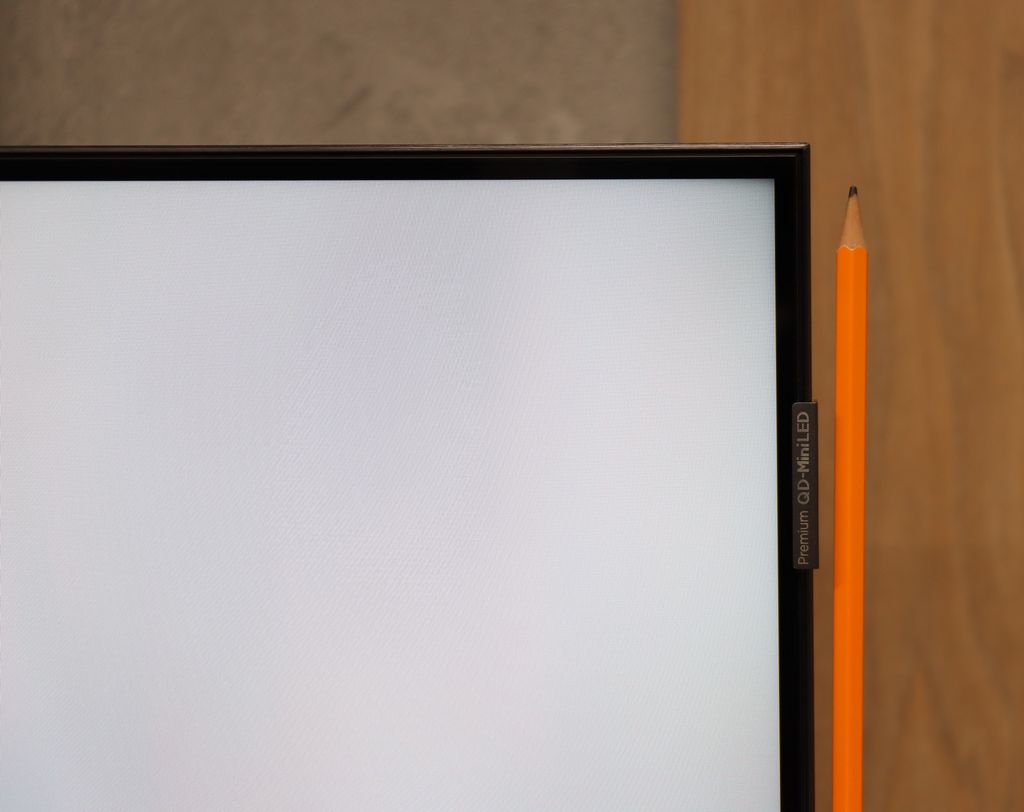
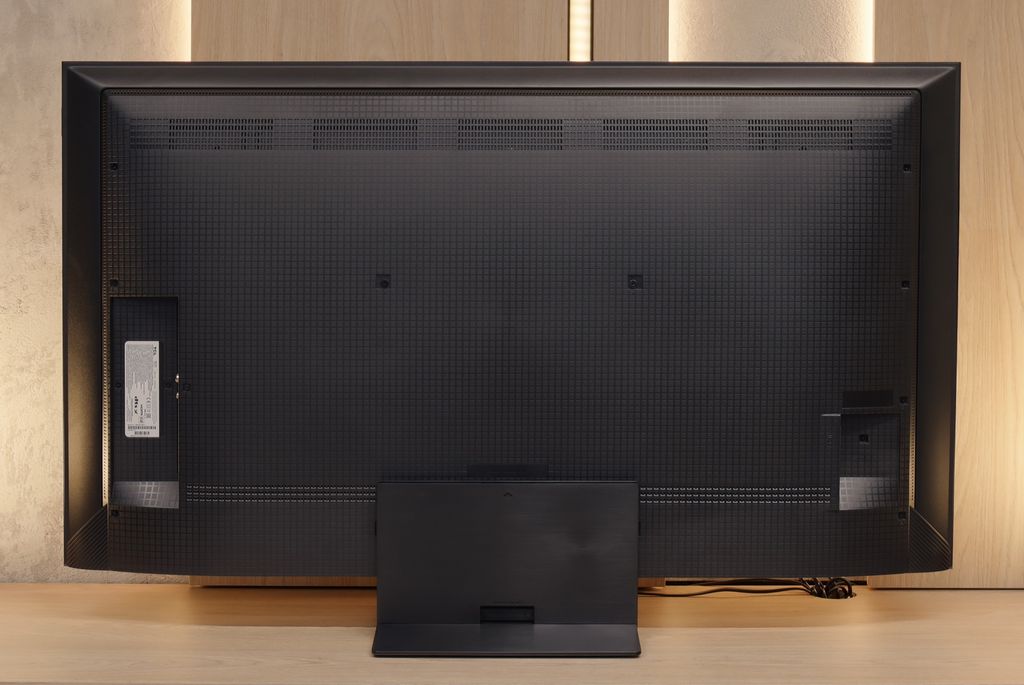
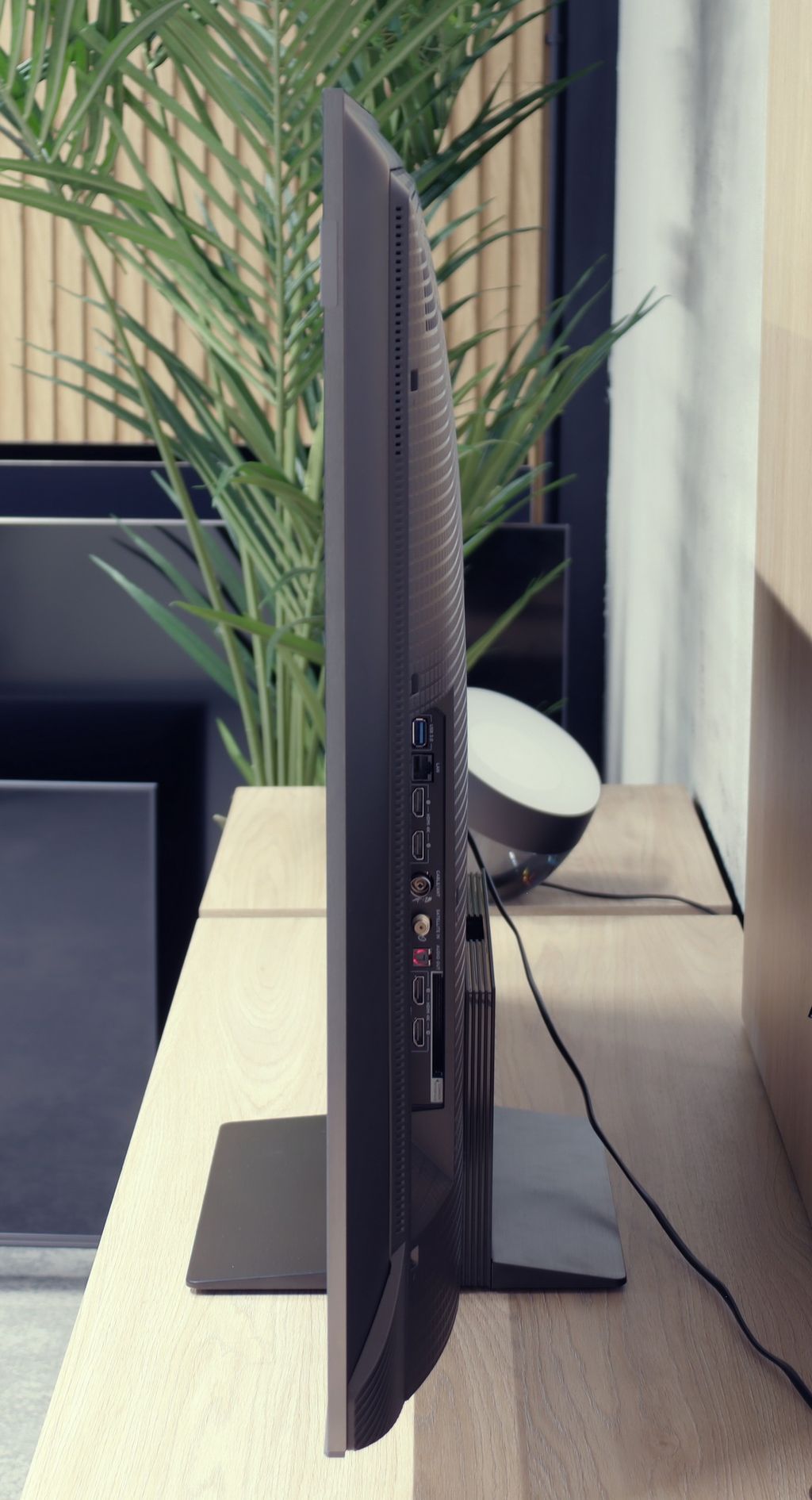
Contrast and black detail
5.6/10
7.1/10
Local dimming function: No
Local dimming function: Yes, number of zones: 336 (14 x 24)
Contrast:

Result
3,400:1

Result
4,200:1

Result
5,200:1

Result
5,050:1

Result
3,650:1

Result
161,000:1

Result
18,750:1

Result
13,150:1

Result
6,300:1

Result
4,200:1
Halo effect and black detail visibility:

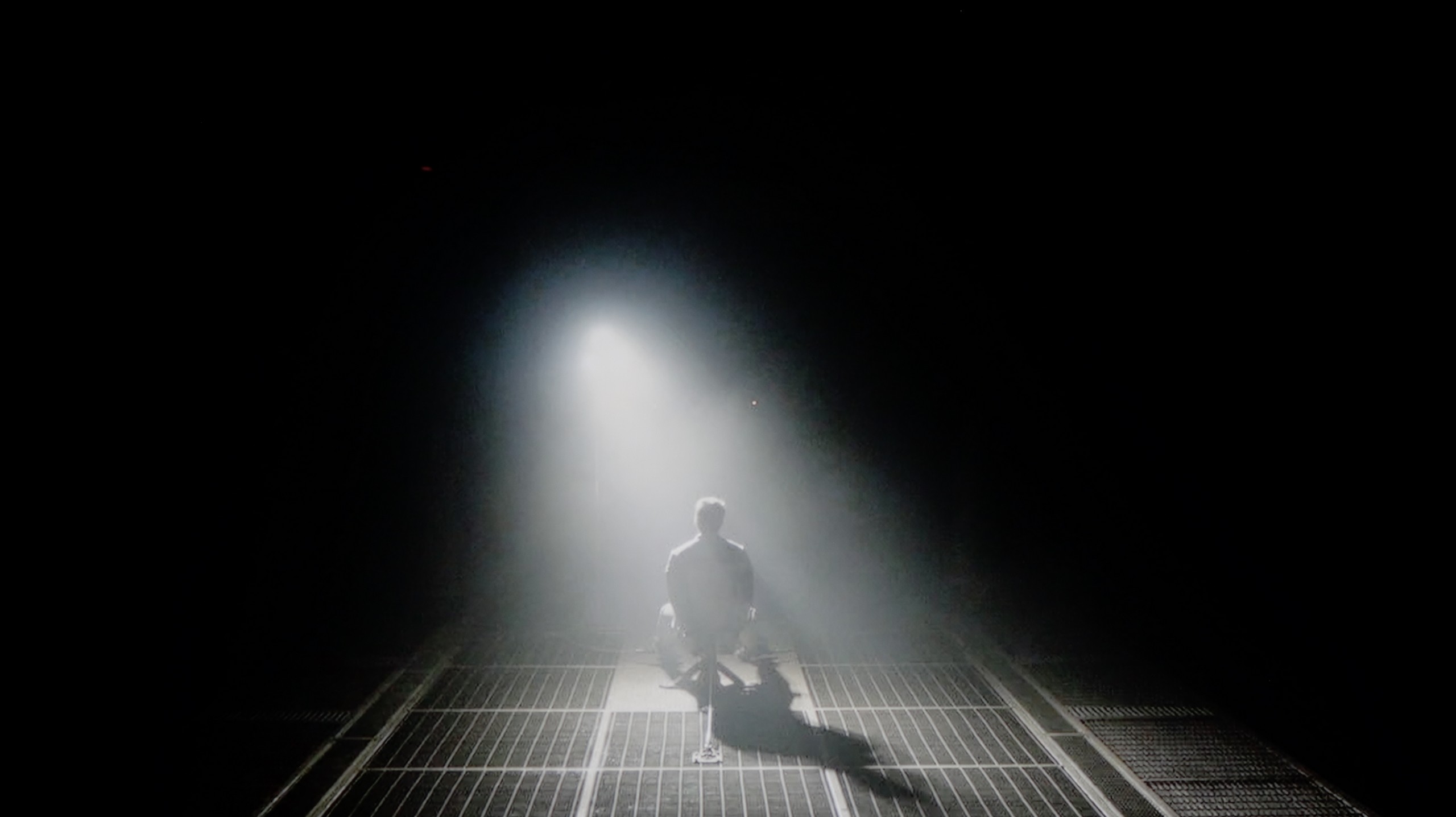
The Hisense S7NQ CanvasTV is a television equipped with a VA panel, which in itself provides decent contrast. This is confirmed by our test charts – an average score of around 4000:1. It's not a stunning value, but for this class of device – quite decent. Perhaps the result would have been significantly better if the television had been equipped with local dimming technology, however, unfortunately, this model lacks it. As a result, blacks in a completely darkened room resemble shades of navy or grey rather than pitch black. This situation causes a slightly noticeable clouding effect. Generally, it's okay, but without much enthusiasm.
The 50-inch TCL C7K that we tested surprised us right from the start – it’s the smallest model in the series, yet it comes equipped with a VA panel with MiniLED backlighting and – attention – as many as 336 dimming zones. For comparison: many significantly larger televisions from higher tiers would be eager to boast such a number. Here we have it in the 50-inch version. Sounds promising, doesn’t it? So how does this translate into real movie-watching experiences? In the vast majority of tested scenes – very well. The contrast was high enough that it reached even six-digit values in measurements, which practically means very deep blacks and well-separated highlights. In scenes from films like The Revenant or Oblivion, the effect was impressive, matching the best LCD screens in this class.
However, not everything went perfectly. Despite the impressive number of zones, managing them was not always exemplary. In more complex scenes, where small light sources or a high level of detail appeared, the television had issues with the so-called halo effect (a glowing halo around bright objects) or overly aggressive dimming of the image. In such situations, contrast could either collapse due to overexposure of certain zones or, conversely – details in bright areas disappeared because the zones suppressed the light too much. Nonetheless, it is worth noting that in the vast majority of scenes, the contrast was more than satisfactory. And taking into account the size of the television and the price, the final effect will satisfy not just average users.
HDR effect quality
5.6/10
5.4/10
Luminance measurements in HDR:

Result
455 nit

Result
414 nit

Result
438 nit

Result
451 nit

Result
470 nit

Result
1051 nit

Result
185 nit

Result
454 nit

Result
200 nit

Result
836 nit
Scene from the movie “Pan” (about 2800 nits)


Scene from the movie “Billy Lynn” (about 1100 nits)


Static HDR10


Dynamic: Dolby Vision
Dynamic: Dolby Vision


HDR luminance chart:
TCL C7K / QM7K
Luminancja HDR
Luminance of RGB colors
Hisense S7NQ CanvasTV
Luminancja HDR
Luminance of RGB colors
When it comes to the brightness of the television and how it handles bright elements while watching films, it is simply average – similar to the case with contrast. The average brightness level of the Hisense S7NQ is around 500 nits. This is a value that allows one to feel the beginnings of true HDR, but it is definitely too little to speak of remarkable effects. However, the television should be praised for its colour gamut coverage – films look very colourful and vibrant. Thanks to the use of PFS LED (QLED) coating, the device is capable of covering over 90% of the DCI-P3 colour palette and over 72% of the wider BT.2020 palette. For a television of this class – these are really very good results.
TCL C7K is one of the brightest MiniLED televisions in its price range. Under the best testing conditions, the screen managed to achieve over 1200 nits, resulting in impressive, at times almost blindingly bright scenes. And most importantly – this is not just a theory based on measurements. In practice, the brightest parts of films can shine with true cinematic grandeur. Fans of home HDR cinema should be truly satisfied.
The impression is excellent, especially in scenes with large areas of brightness – a white sky, explosions, sun reflections, or magical sunsets can surprise with an intensity of light that is rarely seen in this price range.
However, it gets a bit worse when more challenging scenarios appear on the screen, as described when discussing contrast – that is, images full of details, with small, bright elements on a dark background. In such cases, the C7K often decides to preserve black levels at the expense of brightness. An example? Scenes from the films Sicario 2 or Life of Pi, where small light sources (like a distant lantern) can become less visible, and details in the lights are simply dimmed or blend into the background.
For many viewers, this may be an acceptable compromise – as we achieve deep black levels and a pleasing plasticity of the image. Nevertheless, it is worth being aware that the visibility of small details in bright areas is not this model's strongest suit. It is simply a technological limitation that still exists – even with over 300 zones.
Factory color reproduction
7.2/10
6/10


Factory Mode
After calibration
Let's now check how the Hisense S7NQ CanvasTV performs in colour reproduction in the best factory mode, which is Filmmaker. Right from the start, it is clear that it is decidedly better than in dynamic or standard modes, but there are still a few things to nitpick. Regarding image quality from an HD signal, the colours are slightly inaccurate – there is a dominance of cooler shades of blue and a lack of red. This makes the image appear somewhat too cool.
A similar effect can also be observed with 4K content, but there it is much more noticeable. The excessive exposure of blue tones and the lack of red result in the image appearing distinctly cold. However, the biggest problem with this television is not the colours themselves but the way brightness is managed. The tested unit slightly boosted brightness compared to the reference value. While this results in better visibility of details, it comes at the cost of significantly brightened blacks – causing the entire image to seem more "flat".
A similar phenomenon was noticed in the 4K signal – the slightly elevated curve at the beginning of the EOTF chart shows that the television has a tendency to overexpose certain scenes. Fortunately, this effect can be improved with professional calibration, which we will discuss in the next point.
A new feature in TCL televisions for 2025 is the long-awaited Filmmaker mode, which until now has been found in most competing brands. This is great news, as this mode is considered to be the truest to the original vision of the creators and is often recommended by enthusiasts of good picture quality. Unfortunately, as is often the case, the mere presence of this mode does not guarantee perfection. The Filmmaker mode in the TCL C7K is not without its flaws. There can be criticism of the incorrect white balance, particularly a slight dominance of blue, which resulted in cool, somewhat greyish skin tones. But that was not the biggest issue. The main complaint was the excessive brightness exposure, which is clearly visible on the gamma and EOTF graphs. The image was simply too bright, at times even blown out, which affected not only the texture of scenes but also the overall viewing experience. Some details were simply lost, and the entire image looked as if someone had slightly overcooked the brightness slider. As always, we decided to check what could be extracted from this after calibration. And that’s where it started to get really interesting…
Color reproduction after calibration
8.3/10
7.5/10




The results we achieved after calibrating the Hisense S7NQ are really very good. Thanks to the calibration, we managed to eliminate the excessive exposure of blue tones and deficiencies in red with HD signal. A similar, albeit slightly weaker effect was also achieved with 4K HDR content. Managing brightness in HD material has also been improved – the television no longer has issues with brightening the image "across the board."
However, there are things that cannot be bypassed. The characteristic of the EOTF curve has practically not changed, and the lack of local dimming means that the smallest elements on the screen will always be slightly overexposed. One simply has to come to terms with this when choosing a television with a similar type of backlighting. Despite this, the final effect is very good and should fully satisfy the vast majority of users.
After calibration, the TCL C7K showcased itself in a really good light, especially when it comes to SDR content. We managed to precisely tune the white balance, colour gamut, and brightness characteristics to the point that colour errors on the ColorChecker palette dropped below a value of 2. For the uninitiated – this is nearly a perfect result, which means that the image is very close to what the creators intended. Unfortunately, the situation was worse with 4K HDR content. Although we managed to gently stabilize the white balance and correct its previous errors, it was still evident that the television has certain "MiniLED traits," especially in brightness management. When we checked how the C7K handled the EOTF curve on actual film scenes, rather than just on synthetic test patterns, it turned out that the screen still tends to slightly brighten the entire image. This impacts the overall experience – blacks lose some depth, and the image becomes less contrasty than it should be. Despite these minor shortcomings in HDR content, the overall reception of materials – especially in SDR – is truly very good. After calibration, the C7K can display an image that can compete successfully with much more expensive models. Good colour tuning, natural skin tones, and pleasant brightness make movie sessions and everyday viewing of content more than satisfactory.
Smoothness of tonal transitions
9.2/10
8.6/10












The fluidity of tonal transitions is one of those categories that even less advanced users can notice. If someone doesn't understand what it means — we're explaining it now. It concerns whether the colours blend smoothly into one another or if their "gluing" is visible in the form of distinct bands. Good tonal transitions are those that are natural and smooth, without large jumps in colour.
The Hisense S7NQ performs very well in this category, although it must be admitted that it fares slightly worse than Samsung The Frame. In very bright scenes, slight imperfections can be noticed, but you really need a keen eye to catch them. Overall, as with most "frame" style televisions, it still performs excellently.
The TCL C7K handles colour gradation very well – in most of the tested scenes, tonal transitions were smooth, and colours blended together without visible outlines or the artificial "blot" effect. In everyday use, it's hard to find anything to criticise – the picture looks natural, without annoying transitions or digital artifacts. Certain limitations only arise in very dark tones – particularly in a heavily muted grey palette, where the television may struggle to reproduce the ideal gradation. But this is absolutely understandable, as even many significantly more expensive models in this regard simply falter. Fortunately, these situations are rare and do not significantly impact the overall impression.
Image scaling and smoothness of tonal transitions
5.5/10
5.5/10
Smooth transition function


Image without overscan on the SD signal


Equally important is how the television handles tonal transitions on a poor signal – for example, in older films, television, or on YouTube. Unfortunately, despite the presence of the "Smooth and Gradient Picture" feature, which was supposedly meant to improve this aspect, its performance is truly poor. It's barely noticeable that it has any real impact on the visibility of colour transitions.
The image scaling is also lacking. Yes, it can be observed that the television tries to "enhance" the quality, but the end result is far from ideal. The image often appears slightly jagged, which is particularly noticeable in the example of tree branches in the background. Additionally, the Hisense S7NQ has a clear tendency to crop the image at lower resolutions, causing subtitles in news items or finer details in the image to be missed.
TCL C7K is equipped with a feature that, according to the manufacturer, is meant to smooth out unwanted colour transitions – a sort of rescue for less successful tonal shifts. It is called "Gradual Smoothing" and… well, it sounds ambitious, but in practice it works very poorly. Regardless of whether we set it to a low or high level, the difference is minimal. Worst of all, the feature can cut out elements from the picture that should be there. Fortunately, film grain remains untouched, so at least it doesn’t smooth everything indiscriminately, but still – it’s better to simply turn this option off.
When it comes to scaling lower resolution content, it is somewhat better. SD and HD materials look quite decent, although at times we had the impression that the image loses sharpness and becomes too soft – as if something took away its definition. Fortunately, with very low sources (e.g. 576p), there was no overscan effect, meaning the picture was not artificially cropped – everything fit on the screen as it should.
Blur and motion smoothness
6.5/10
7.5/10

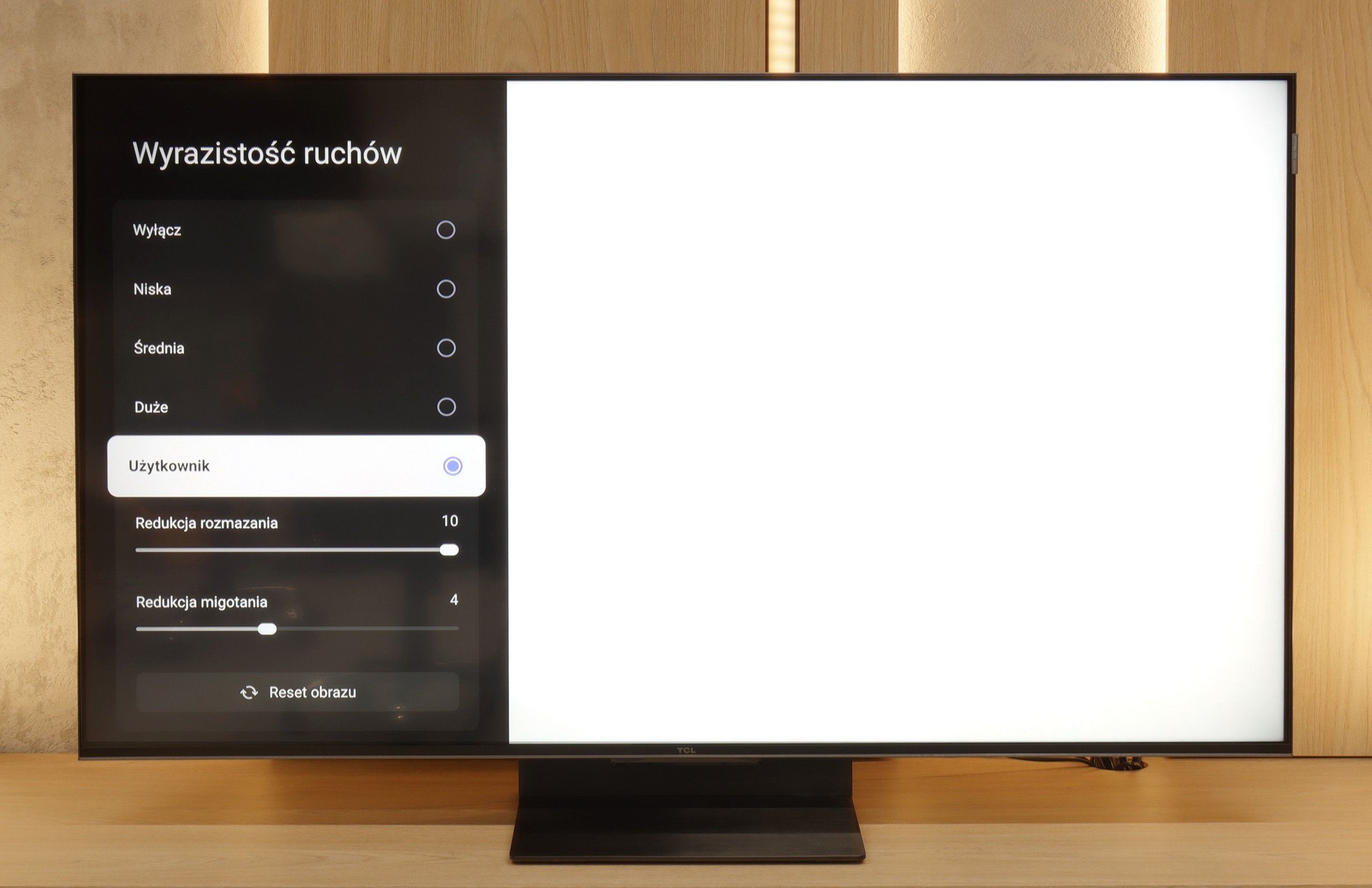
Blur (native resolution, maximum refresh rate):





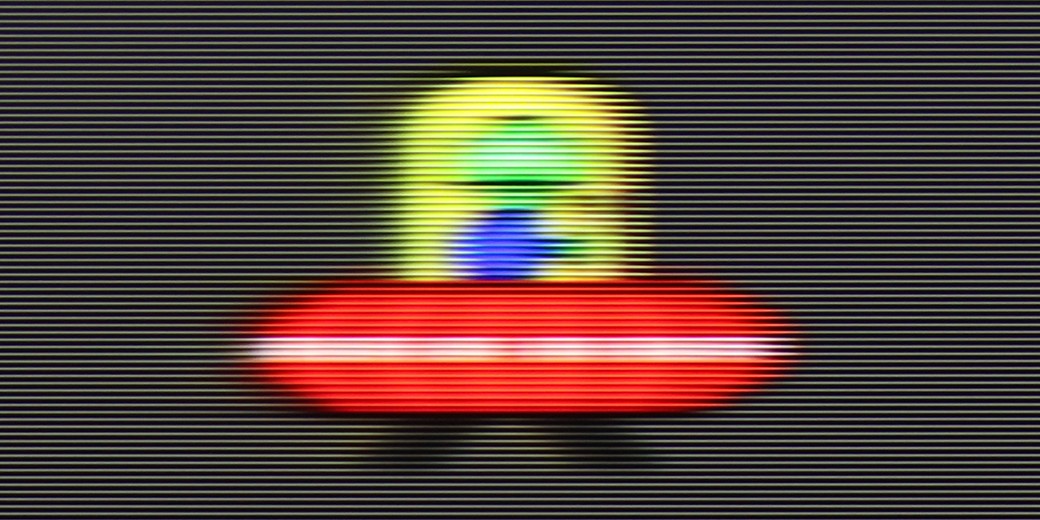
Blur (BFI function enabled):



Smużenie ():
Smużenie (4K 144Hz):



When it comes to motion fluidity, the television performs remarkably well. Although the S7NQ was designed primarily for displaying static elements – such as images – the manufacturer has implemented a 144 Hz refresh rate matrix. As a result, sports and games look really good on it.
For materials that are not recorded at a high frame rate, the manufacturer has provided two features that allow you to adjust the picture to your own preferences. "Motion blur reduction" and "judder reduction" operate on a 10-point scale, allowing you to choose between a more cinematic image – with characteristic frame jumps – and a smooth effect reminiscent of a "soap opera". How to set this up? That’s a personal matter – we leave the decision to you.
The TCL C7K handles motion fluidity really very well. The matrix used in it offers a refresh rate of 144 Hz, which in itself suggests that this television is more than just a regular "60 Hz" panel. Furthermore – if we connect the C7K to a computer and set the resolution to Full HD. But we'll write more about this in the paragraph about gamers and PC collaboration. Returning to everyday use – both sports and films look very good here. Thanks to the fast panel and well-functioning motion smoothing, the C7K is great for watching matches, but also for movie screenings. In the menu, we find two sliders – motion blur reduction and flicker reduction – which allow us to adjust the fluidity effect to our own preferences. At lower settings, we get a more cinematic effect, with slight stuttering motion. At higher settings – the picture becomes more theatrical, fluid to the point of excess. Everyone has their own preferences – anyone can set it to their liking.
Console compatibility and gaming features
8.5/10
9.8/10
- ALLM
- VRR
- VRR range48 - 144Hz48 - 144Hz
- Dolby Vision Game Mode
- Correct implementation of HGIG
- 1080p@120Hz
- 1440p@120Hz
- 4K@120Hz
- Game bar

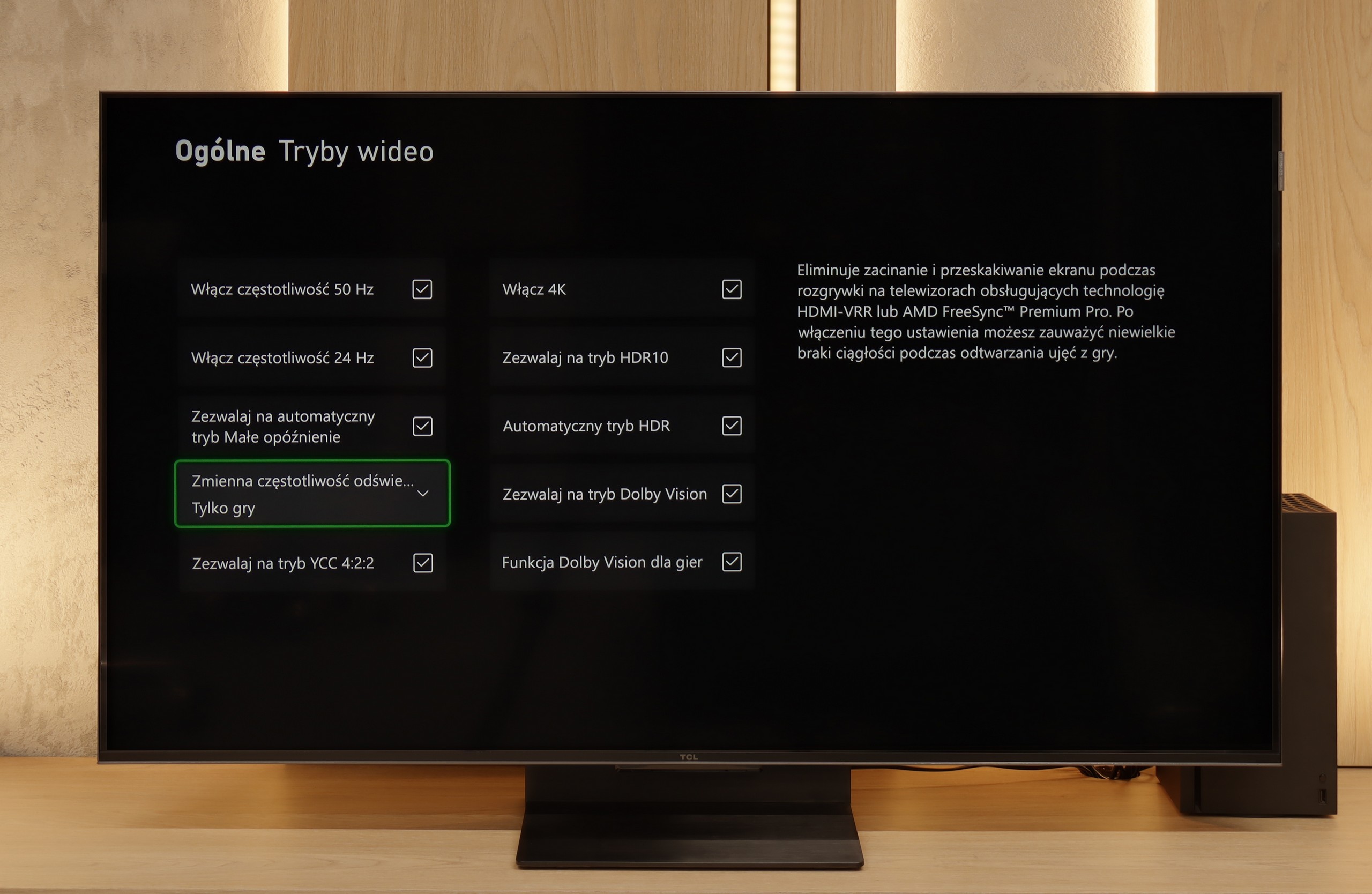

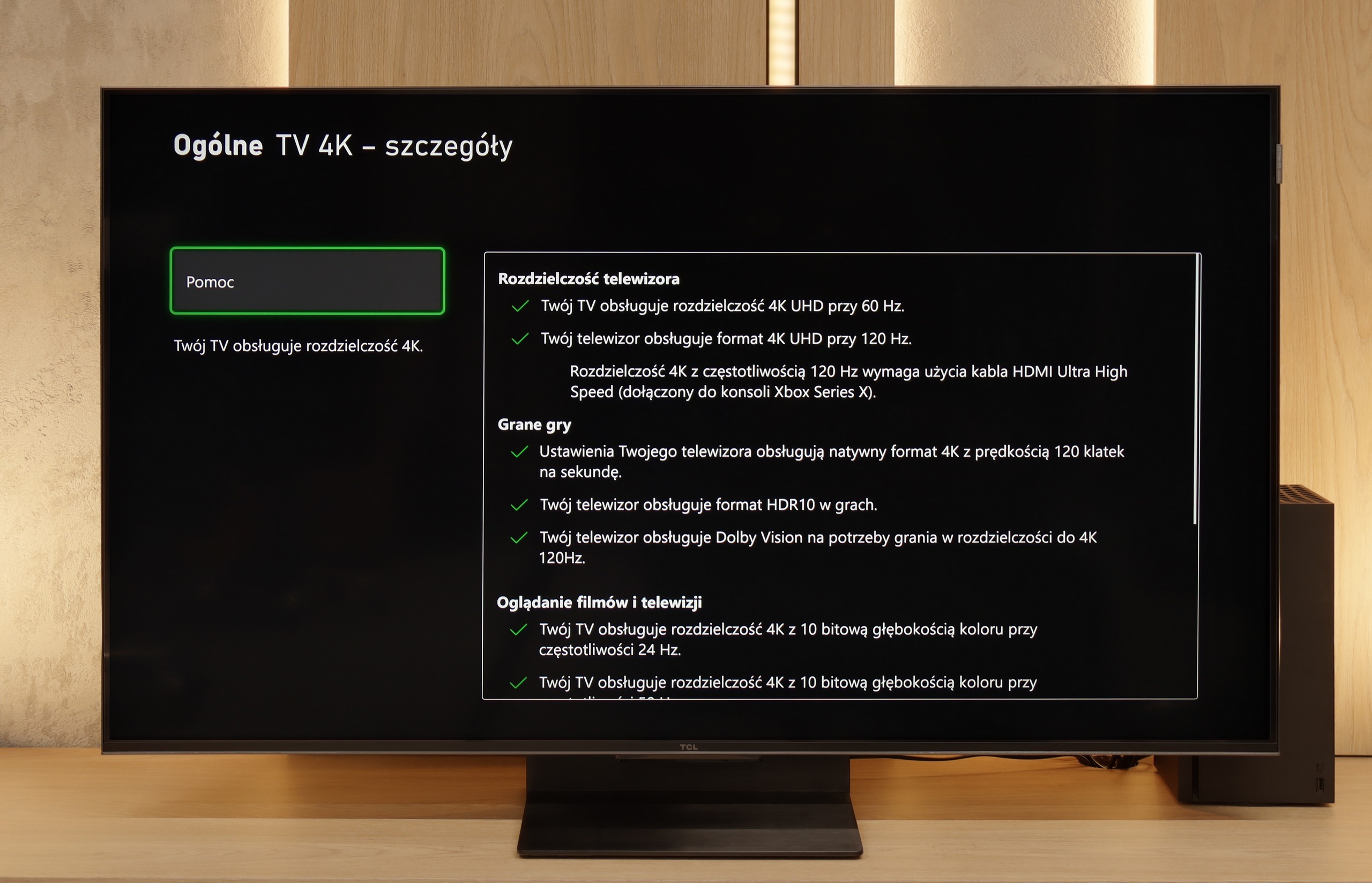

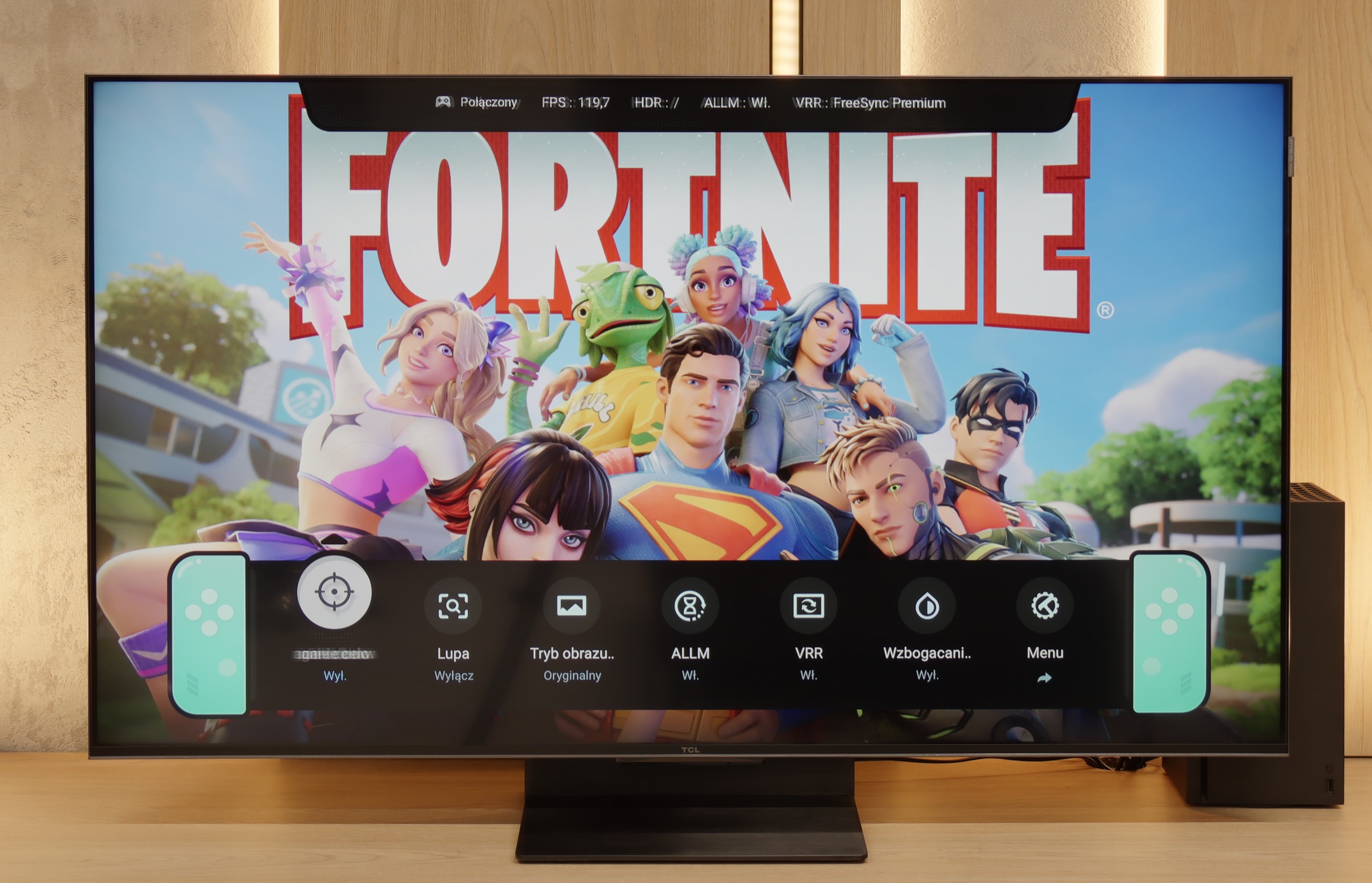

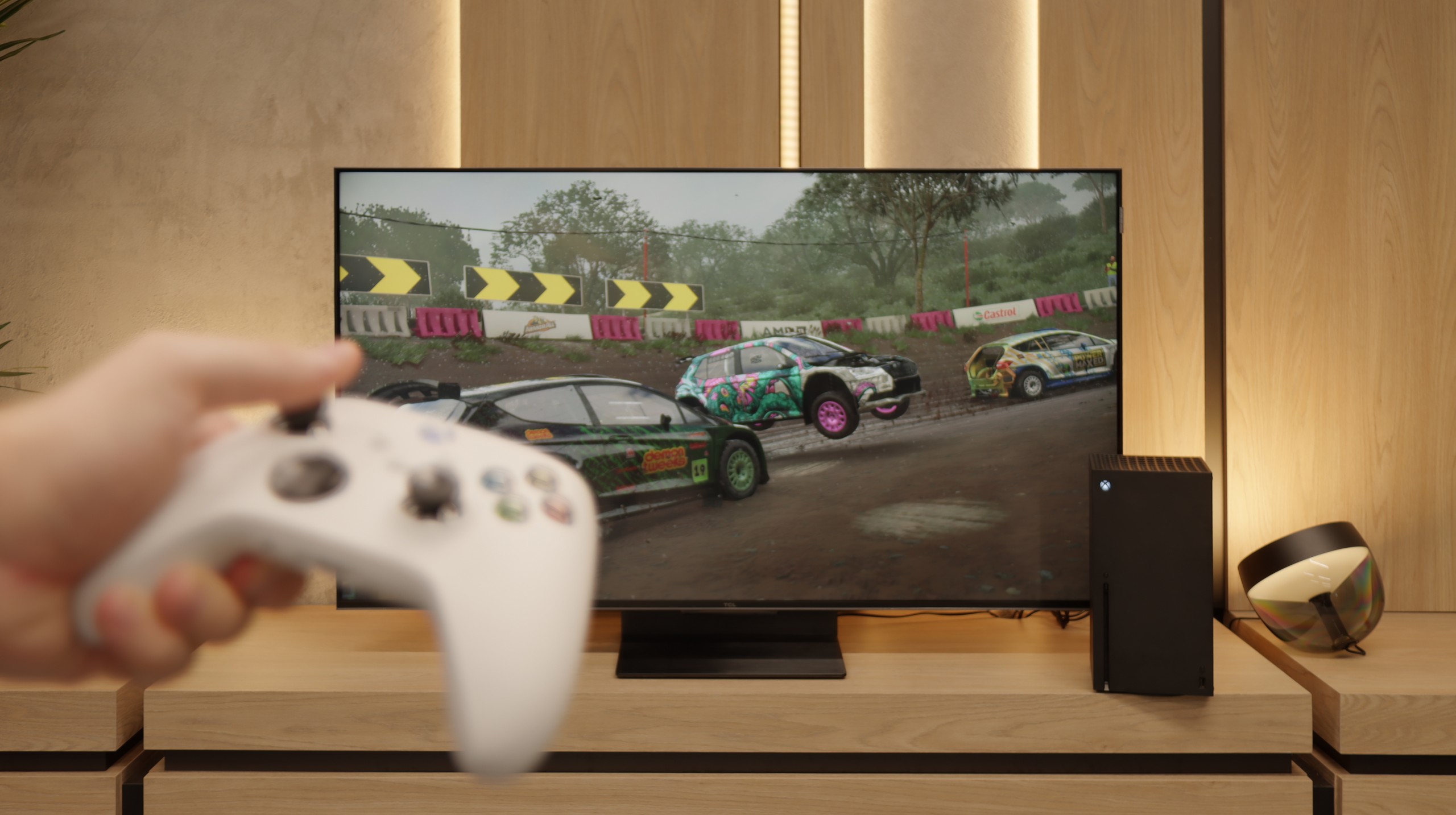
Although the S7NQ is a "picture" type television, it can indeed be used for gaming. Really. Here you can find almost everything (except for the HGiG mode) that a modern gaming television needs. The 144 Hz panel and two full-fledged HDMI 2.1 ports allow for the hassle-free connection of two consoles, such as the PlayStation 5 or Xbox Series X/S.
The television supports Automatic Low Latency Mode (ALLM) and Variable Refresh Rate (VRR), with no stuttering or issues. It also handles displaying high frame rates at lower resolutions without any trouble. Hisense deserves praise for a very attractive Game Bar – it displays all available picture options, and additionally, we have the ability to enlarge the minimap or turn on the crosshair (because sometimes someone might actually want to "aim" 😉).
The only missing element – as we mentioned earlier – is the lack of a proper implementation of the HGiG mode. It is specifically responsible for automatically adjusting the picture in games as the creators intended. It's a shame, because that’s the only thing preventing the Hisense S7NQ from being a full-fledged gaming "beast".
The TCL C7K is a television that on paper appears to be the dream equipment for gamers – and most importantly, it holds up in practice too. To start with good news: there are two full-bandwidth HDMI 2.1 ports, so we can easily connect both a console and a computer, taking advantage of all their capabilities. The panel itself supports a refresh rate of 144 Hz, which gives a significant advantage in dynamic games. There is also a complete set of gaming features: VRR (variable refresh rate), ALLM (automatic low-latency mode), and support for Dolby Vision in games. There is also the HGiG mode, which allows for HDR effects consistent with the creators' intentions. GameBar, an information bar for gamers. It works quickly, looks clear (like a Nintendo console👌), and shows what matters most: the current frame rate, VRR status, and even HDR parameters.
Input lag
8.7/10
9.7/10
SDR
HDR
Dolby Vision
Input lag in the Hisense S7NQ is decent, though it cannot be said to be extraordinary – especially by the standards of 2024/25. Values around 30–20 ms may not be very high and the average player is unlikely to notice it, but those who spend a lot of time gaming may experience a slight discomfort.
The situation is definitely better when playing in Dolby Vision mode – then the latency is lower and the gameplay feels more pleasant. The problem is that there are still few games supporting this mode, and they are mainly available on the Xbox console.
When it comes to delays, the C7K gives no reason for complaints. In games at 120 Hz, input lag is around 10 ms, which means the television responds really quickly. And interestingly – even in Dolby Vision mode, the result is very similar, which is not always the standard. Good job, TCL. At 60 Hz, the lag does increase a bit, but that's completely normal and affects virtually every television with a refresh rate of 120Hz and above. The most important thing is that everything still runs smoothly and there’s no feeling that something is not responding to our actions.
Compatibility with PC
7/10
8.4/10

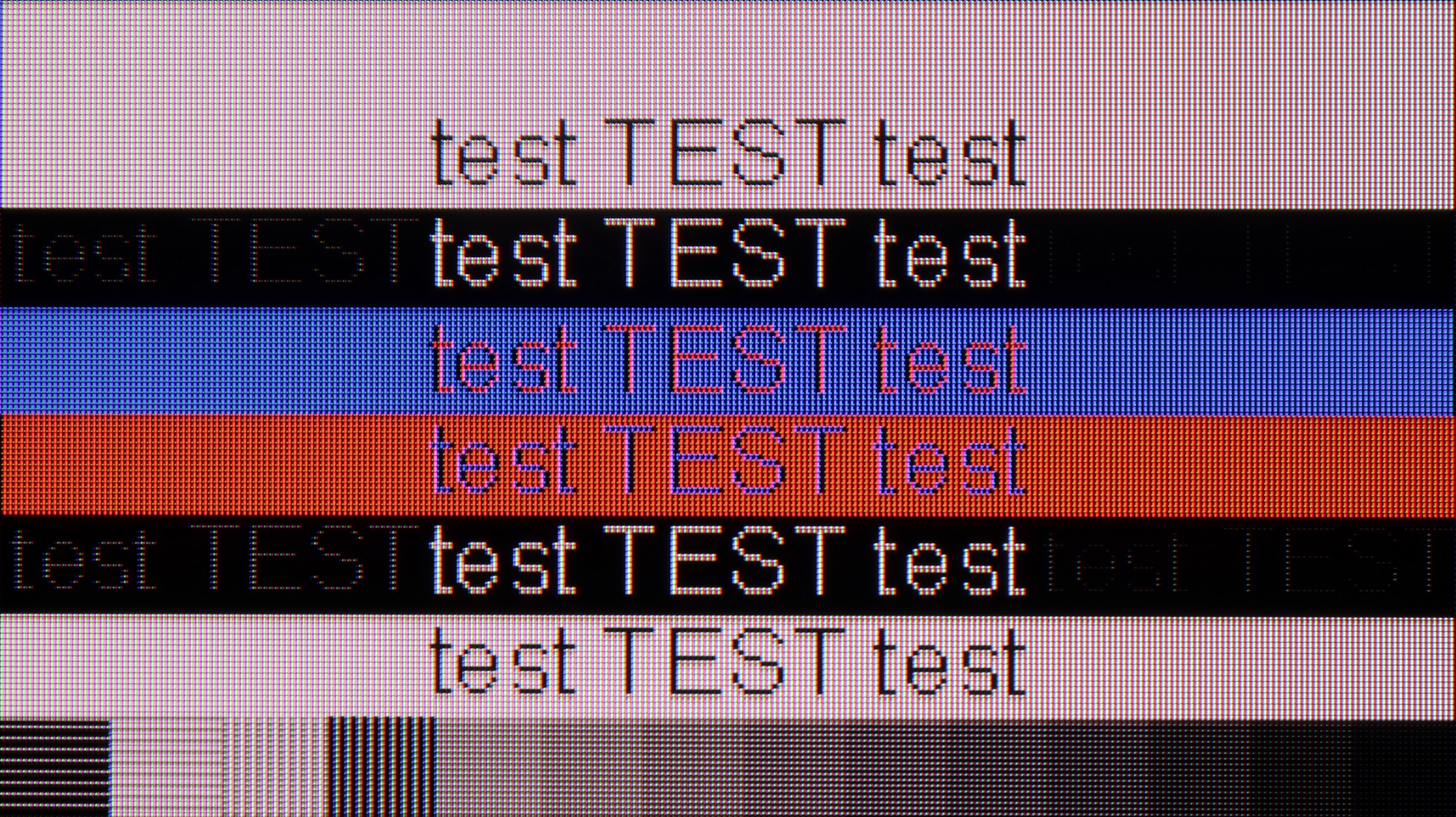
When it comes to working with a computer, the S7NQ Canvas TV performs really well. Gaming on it is seamless thanks to the presence of a 144 Hz panel and support for G-Sync with Nvidia cards. Input lag – as we mentioned earlier – is good, though not exceptional.
And what about work? It’s doable. The television has a correct implementation of chroma 4:4:4, so fonts look quite clear. You might nitpick about some minor issues with the thinnest letters on a dark background, but let's be honest – rarely does anyone sit a metre away from a 55-inch screen reading small text.
If we are going to connect the C7K to a computer – especially for gaming – there is definitely a lot to play for. We have 4K at 144 Hz, which already sounds great, but if we lower the resolution, the television can even display up to 280 Hz. In e-sports, where every fraction of a second counts, this really makes a difference. On top of that, there is support for G-Sync and FreeSync, so regardless of which graphics card we have – the image will be smooth, without any stuttering or tearing.
However, if we plan to place the C7K on a desk and use it like a monitor, it’s a bit less "rosy." Yes, it supports chroma 4:4:4, so fonts should be sharp, but with very dark letters, there is slight blurriness and dimming of the edges. This is not something that immediately stands out during gaming or watching, but when working with text – it can be distracting. In everyday use – it’s probably nothing to worry about, but if we plan to place a 50-inch screen a meter from our face, it’s worth keeping this in mind.
Viewing angles
3.4/10
3/10
The viewing angles here are typical for a VA panel. The S7NQ loses quite a bit when viewed at around a 45-degree angle – the colours fade, and the brightness clearly drops. It’s a pity, because after all, this is a television that is meant to display works of art – it would be nice to be able to look at them from different places in the room, not just straight on.
There are no surprises here – the C7K has classic viewing angles for a VA panel. That is: sitting directly in front – it’s excellent. The colours look good, the contrast is strong, everything is in place. But just shifting slightly to the side and it starts to get worse – the image loses saturation, blacks turn grey, and the overall impression diminishes a bit. So, if we plan to watch together with a few people or have a sofa that takes up half the living room – it’s worth seating everyone a bit more centrally. You can watch from the side, but don’t expect miracles – it’s simply a characteristic of VA panels.
TV efficiency during daytime
5.4/10
6.1/10




Matrix brightness
Average luminance SDR
TCL C7K / QM7K: 475 cd/m2
Hisense S7NQ CanvasTV: 497 cd/m2
The Hisense S7NQ Canvas TV is equipped with a matte display, which quite effectively suppresses reflections – very similar to its Chinese rival, the TCL A300 NXTVision. Unfortunately, both designs fall short in this category compared to Samsung's The Frame, which offers a significantly better anti-reflective coating. In the case of the Chinese models, including the S7NQ, colours fade quite noticeably under light, and black performs poorly in such conditions. The brightness of the television reaches around 500 nits – a fairly decent value for a matte screen, but still lower than that of the aforementioned The Frame. Generally, if someone prefers matte displays, well... it looks like it looks – Samsung simply did it better.
Fortunately, the TCL C7K performs quite well in bright rooms. The applied panel has a satin finish that effectively suppresses reflections, which means we don't have to worry about lamp or window reflections even on sunny days. Importantly, the colours maintain their intensity and do not wash out, as can happen with weaker matte panels. In terms of brightness, the average for content like YouTube or regular television is slightly below 500 nits. This is not a record-breaking result – for example, the MQLED85 (C765) performs better in this regard. However, for everyday viewing during the day, it should work without major issues, provided we do not plan to place it opposite a south-facing window without curtains.
Details about the matrix
Subpixel Structure:
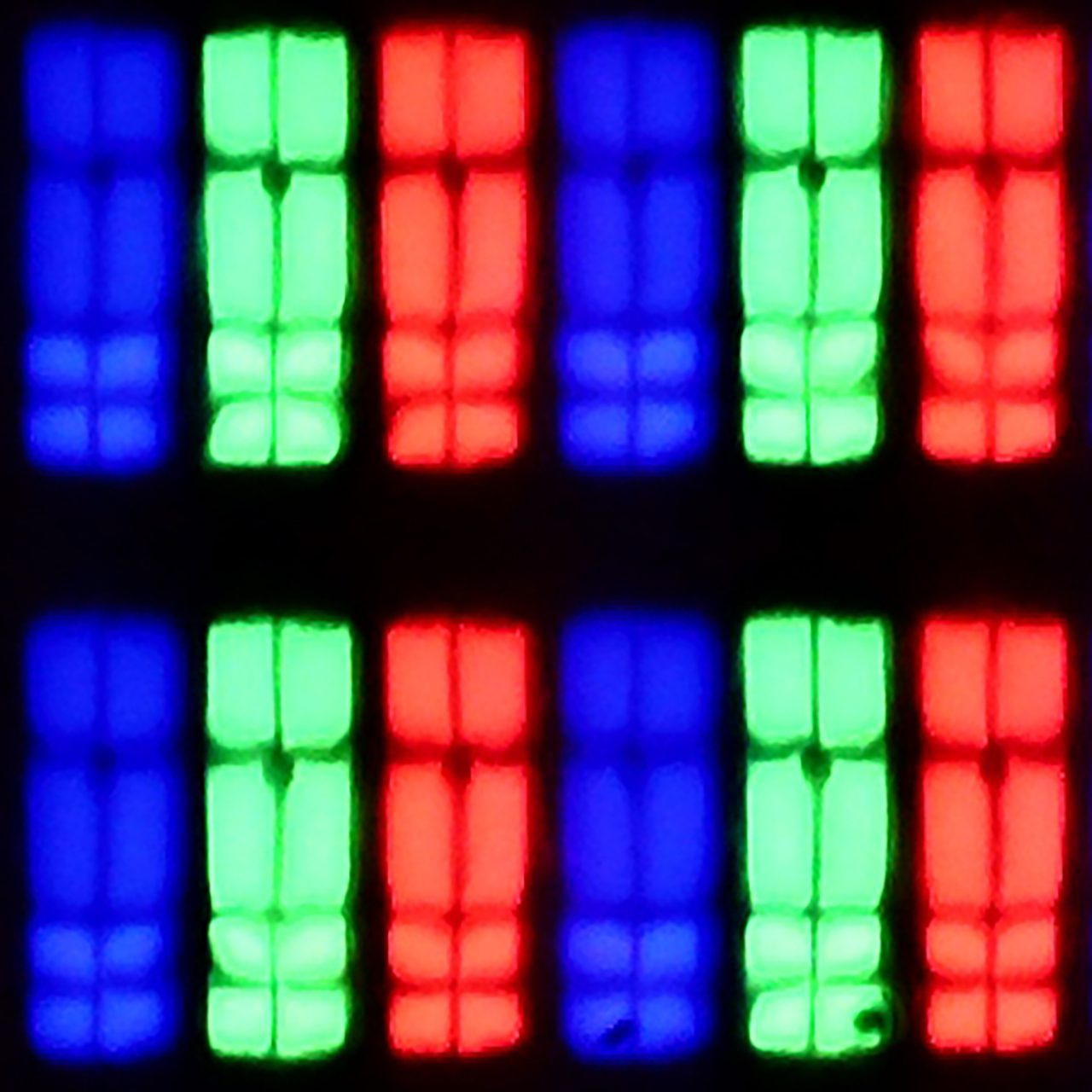
Panel uniformity:


Hisense S7NQ CanvasTV
TCL C7K / QM7K
TV features
9/10
7.7/10
- HDMI inputs2 x HDMI 2.0, 2 x HDMI 2.1 48Gbps2 x HDMI 2.0, 2 x HDMI 2.1 48Gbps
- OutputsToslink (Optical audio), eARC (HDMI), ARC (HDMI)Toslink (Optical audio), eARC (HDMI), ARC (HDMI)
- Network InterfacesWi-Fi 2.4GHz, Wi-Fi 5GHz, Ethernet (LAN) 100MbpsWi-Fi 2.4GHz, Wi-Fi 5GHz, Ethernet (LAN) 100Mbps
- TV receptionDVB-T, DVB-T2, DVB-S, DVB-S2, DVB-CDVB-T, DVB-T2, DVB-S, DVB-S2, DVB-C
Classic features:
- Recording to USB (terrestrial TV)
- Recording programming
- Picture in Picture (PiP)
- RF remote control (no need to aim at the screen)
- Backlit remote control
- Teletext
- Audio only mode
- Possibility to connect Bluetooth headphones to the TV
- Possibility to simultaneously use Bluetooth headphones and the TV speaker
Smart features:
- AirPlay
- Screen mirroring (Windows Miracast)
- Wyszukiwanie głosowe
- Voice search in native language
- Ability to connect a keyboard and mouse




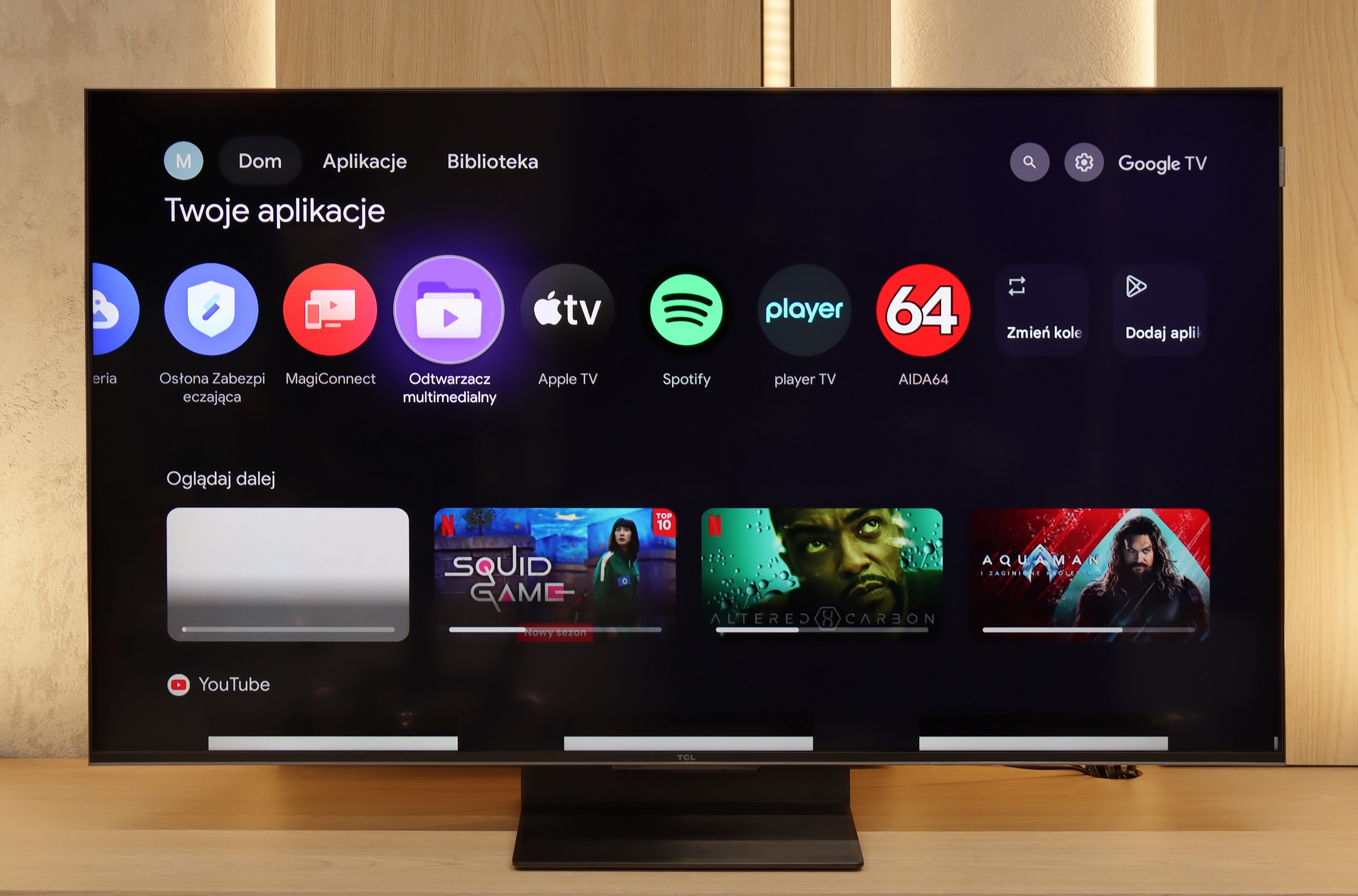
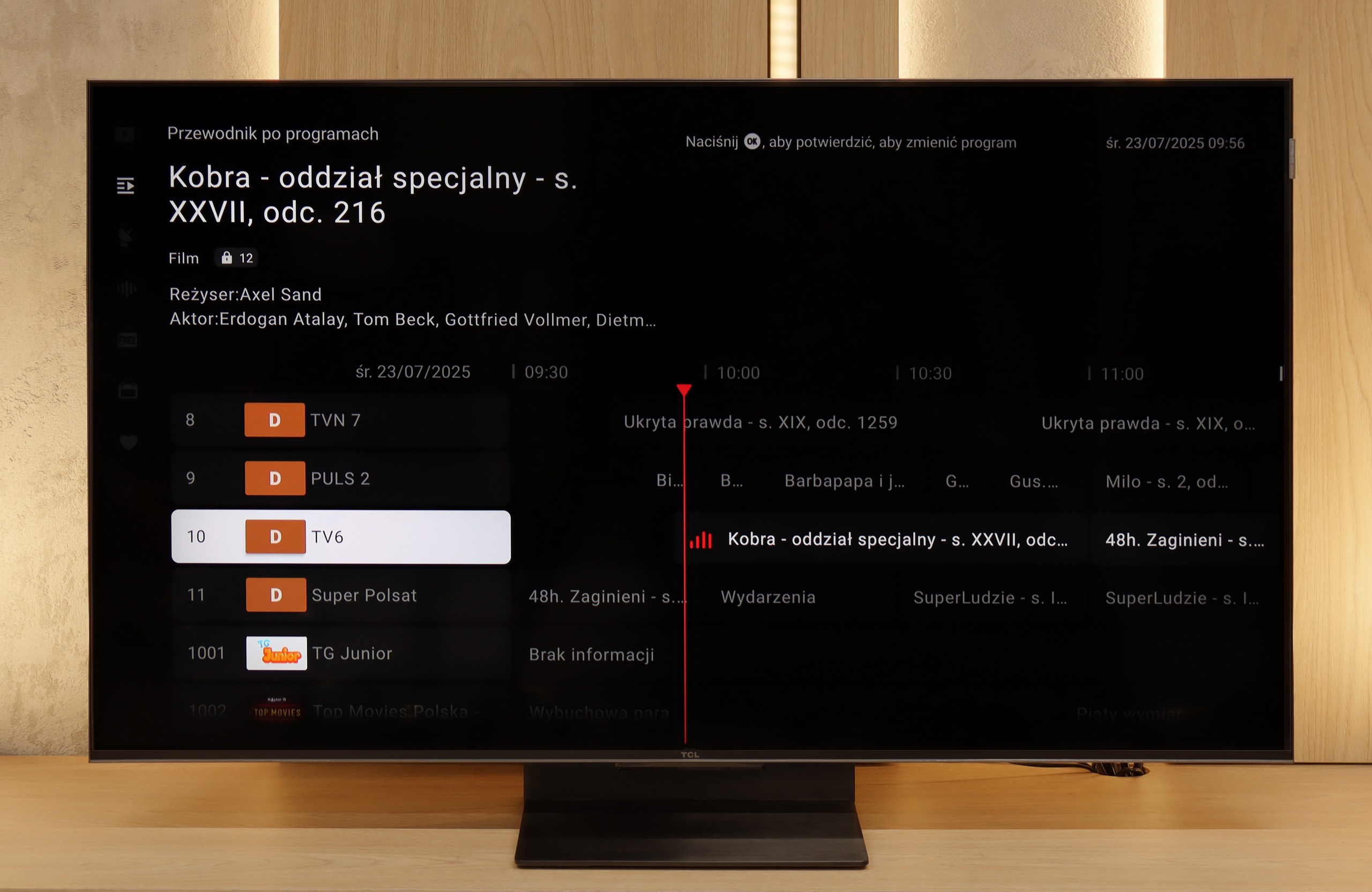
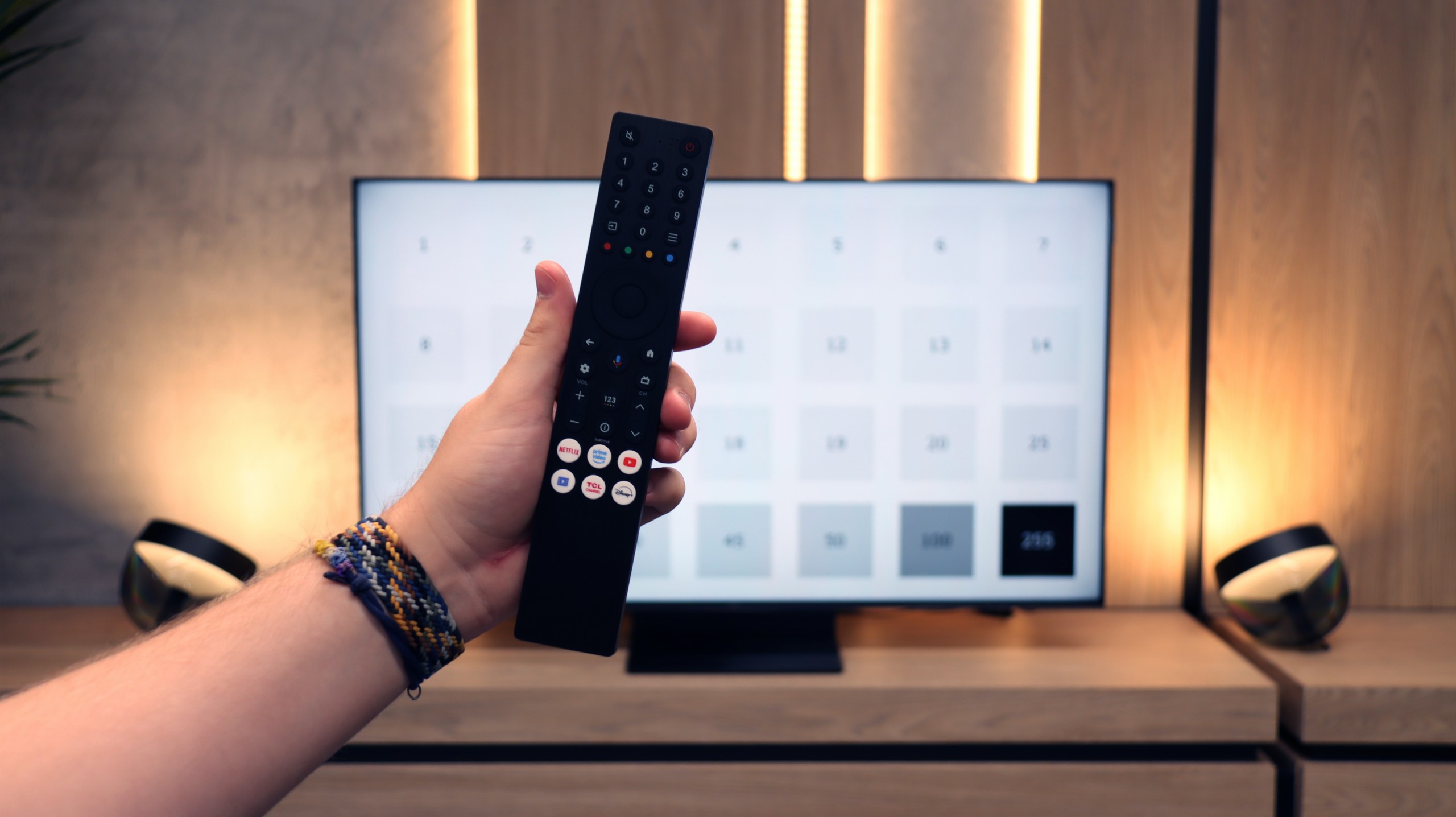
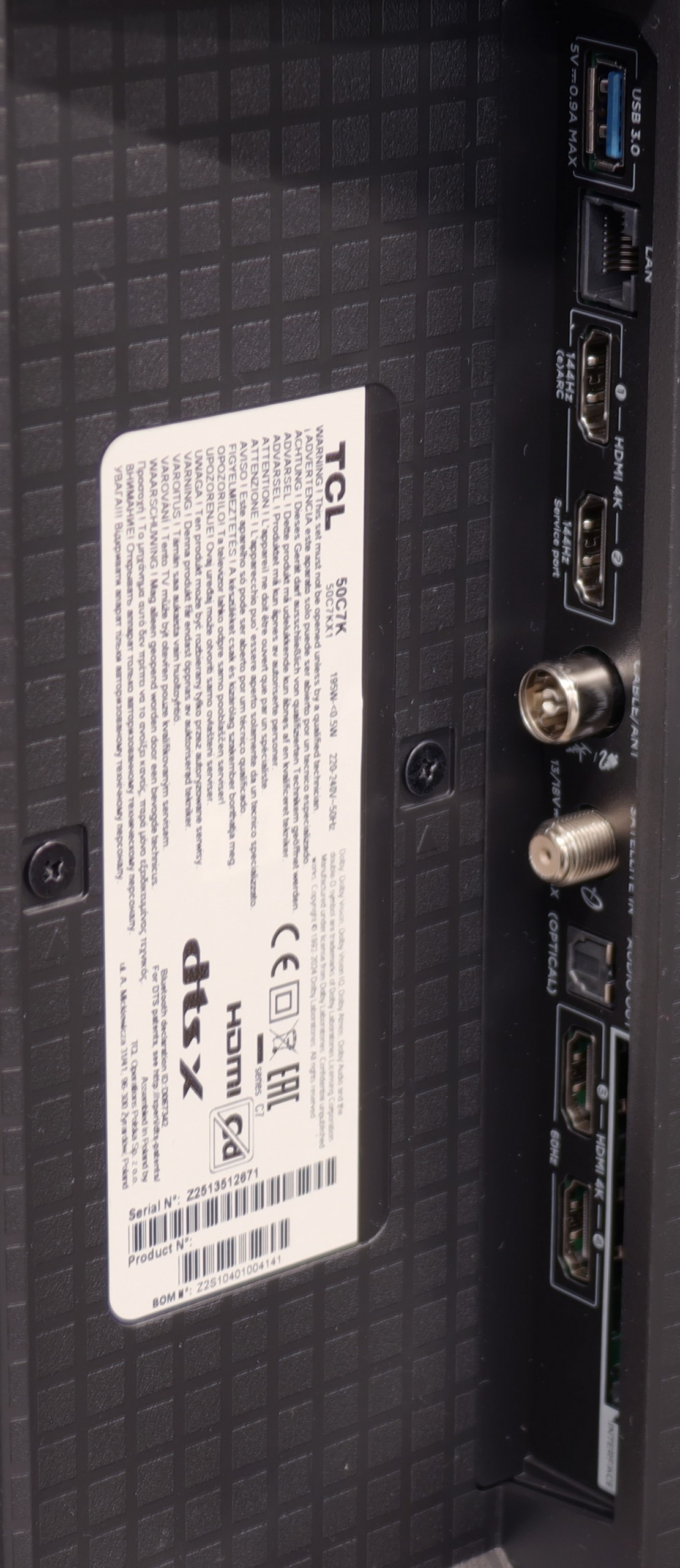
As the Hisense S7NQ is a television designed for a specific purpose, we will start the description a bit differently – from the most important aspect of such models, which is the display of artworks. Like all "art" televisions, it features a special mount, allowing the screen to be installed completely flat. The biggest advantage compared to the Korean Samsung The Frame is the fact that, despite the lesser availability of images in gallery mode, all of them are completely free – there is no need to pay any subscription fees. An additional bonus included with the S7NQ is the light brown frame. This is quite a plus, especially if someone was planning to choose that colour anyway – it can save a bit of money on both the frame and the subscription.
However, when it comes to the quality of the displayed images, unfortunately, it is evident that the Samsung The Frame performs significantly better in this regard. In the S7NQ, the images look more digital, while in The Frame, the Art Store mode offers real scans of artworks, where you can even see the texture of the paint or the brush strokes of the artist. And once again, we return to an old truth – for better quality, you simply have to pay.
Fortunately, the S7NQ is not just an “art piece,” but also a regular television – and it performs really well in that role. Like most Hisense models with the VIDAA system, it has many basic functions such as USB recording, screen mirroring, and AirPlay support. As for applications – the most popular streaming services are present here, and you can find their full list below.
SmartTV: GoogleTV
The greatest strength of the TCL C7K in everyday use is undoubtedly the Google TV system. Thanks to it, we have access to an almost endless library of applications, including some more niche ones that are often unavailable on other platforms. The built-in Google Assistant understands Polish, so we can easily ask what’s on TV, what the weather is like, and even issue a few voice commands to control the television. The presence of Chromecast and AirPlay, which work smoothly and make life easier, is also a plus.
User Functions
On the downside, the classic features are somewhat lacking. Of course, we have the basics – teletext, EPG, and the ability to connect headphones – but that’s about it. There is no USB recording feature or picture-in-picture (PiP) mode, which can still be found among competitors. It’s also worth remembering that Google TV in the TCL edition can sometimes have strangely translated parts of the menu or minor errors in the interface. These are not things that interfere with daily use, but those sensitive to details may notice them.
Playing files from USB
5.4/10
9.2/10
Supported photo formats:
Maximum photo resolution:


The Hisense S7NQ effortlessly plays the vast majority of popular audio, photo, and video formats. So why the relatively low rating in this category? Well – due to software issues. This is yet another Hisense television that did not allow us to open external subtitles in films. Regardless of whether we are talking about the .ass, .srt, .txt, or .sub format – the subtitles simply did not appear.
The most amusing (or rather the most frustrating) thing about all this is that in the menu, we find options to change the font colour, size, and background… The problem is that the subtitles themselves are not visible at all.
The built-in file player in the TCL C7K performs really very well. It supports most of the most popular audio and video formats, so if we want to quickly plug something in from a USB drive and play it – there should be no problem. Of course, as is usually the case, we can find some minor shortcomings – not every exotic codec will work (Apple's HEIC), not all subtitles will be perfectly synchronised (txt.). However, the biggest advantage of this television comes to the rescue, namely Google TV. Thanks to access to the Google Play store, we can easily install an alternative player, e.g. VLC, and then no files will be a concern for us.
Apps
7.7/10
9.6/10














































Sound
6.3/10
7/10
- Subjective sound quality:6.3/107/10
- Dolby Digital Plus 7.1:
- Dolby True HD 7.1:
- Dolby Atmos in Dolby Digital Plus (JOC):
- Dolby Atmos in Dolby True HD:
- DTS:X in DTS-HD MA:
- DTS-HD Master Audio:
When it comes to sound, it presents itself... much like a television on the wall – that is to say, rather flat. Despite the use of a 2.0.2 speaker set with a total power of 36 W, we cannot speak of any exceptional sound quality here. But as is the case in most instances – buying even the simplest soundbar can radically change the situation.
On the plus side, it is worth noting the support for practically all popular Dolby and DTS codecs. This means we can easily connect the television to a home cinema system without having to fiddle with settings or sound conversion.
To be honest, we didn’t expect much from the sound of the 50-inch version of the C7K model. Typically, in such sizes, it’s hard to get anything more than thin, flat sound. But here – a pleasant surprise. The audio proved to be really enjoyable, with good clarity and even a slightly discernible bass. This is probably related to TCL's new collaboration with the Bang & Olufsen brand, which is a novelty for 2025. Whether the C7K actually uses the original transducers from the Danish premium brand – we cannot confirm. But the end result still deserves a thumbs up. For a television without a soundbar – it sounds quite pleasant.


